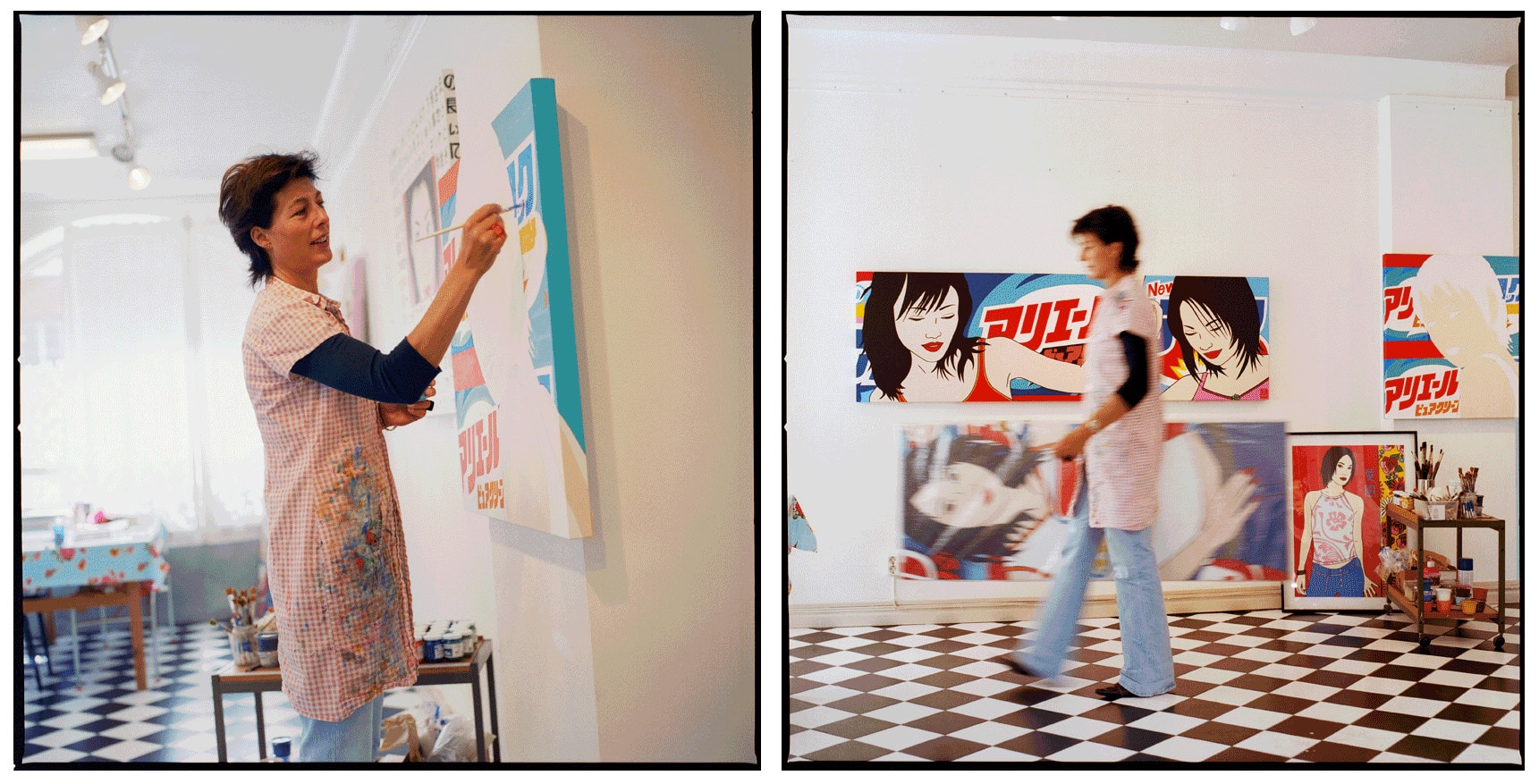MariaManuela’s pictures define the contrasts between the culture of the Far East and the western world’s pop-culture at the same time as they bring the two forms together. She derives her inspiration from classic Japanese woodcuts and their motifs of fantastically coiffured, cherry-lipsticked women, dressed in exquisitely patterned kimonos. But what she presents for the viewer are modern young Japanese women in mini-skirts, dancing among the cherry blossom and haiku poems.

Her Pop Icons are painted in vinyl on linen canvas – layer upon layer laboriously laid down to achieve the effect of a printed, japanned surface. The lines of the lips, the semi-circular contours of the eyes and the billowing coiffures are expressed against a monochromatic background. Her advertisement-like images combine mystique with unequivocal simplicity, setting a stage for all manner of different facial expressions – melancholy, pensive, jovial.

Born in Stockholm in 1959, Maria Manuela Vintilescu’s first serious encounter with art came at the age of seven. It was with fascination that she viewed Niki de Saint-Phalle’s giant sculpture She, then displayed at the Museum of Modern Art in Stockholm. After graduating from the Ecole Française in Stockholm, Maria took courses in painting, drawing and advertising. After ten years as a scene painter in the theatre, she turned to her own art. Her Pop Icons appeared for the first time in 1998. Two years later her Flower Year suite was exhibited in the Stockholm Spring Show at Liljevalch’s Gallery. These twelve female portraits were published in booklet form accompanied by Japanese haiku poetry interpreted by her father, Jan Vintilescu. It was his book that had first introduced this Japanese lyric form to a wider audience of Swedes in 1959.

Since the exhibition at Liljevalchs in 2000, her Pop Icons have been exposed at galeries, art fairs and museums in Europe and elsewhere, like in Tokyo Art Factory in Japan, at Villa Tamaris-Centre d’art in la Seyne-sur-Mer and at SOMA Museum of modern Art in Seoul.

In much the same way as the haiku moves us by the eloquence of its brevity, MariaManuela seeks through her pictures to convey situations, facial expressions and frames of mind by the most sparing and subtle of means. Her father had sought the same in rendering the haikus of the Japanese poet Issa (1763–1828)
Seeing cherry trees
in the blossomed parks of spring
strangers become friends.
Johan Persson
MariaManuela förenar och visar kontrasterna mellan det österländska och västvärldens popkultur i sina bilder. Inspirerad av klassiska japanska träsnitt där kvinnor avbildas med körsbärsröda munnar och stora håruppsättningar, iklädda kimonos i vackra mönster gestaltar MariaManuela den unga, självständiga japanska kvinnan dansande i minikjol omgiven av körsbärsblommor och haikudikter.

Hon målar sina Popiconer med lager på lager av vinyl på linneduk tills målningen förmedlar en känsla av tryckt och lackad yta. Mot en enfärgad fond träder läpparnas linjer, ögonens halvmåneformade konturer och frisyrernas vågformade uttryck fram. Det finns både en mystik och entydig enkelhet i hennes ibland reklamliknande bilder där olika ansiktsuttryck, vemodiga, fundersamma eller muntra får spelrum.

MariaManuela Vintilescu är född i Stockholm 1959 och fick sin första konstupplevelse när hon var sju år. Fascinerad såg hon då Niki de Saint-Phalles jättelika skulptur She, som visades på Moderna museet i Stockholm.

Efter examen vid Franska skolan i Stockholm har hon gått flera utbildningar med inriktning på målning, teckning och reklam. Under tio år arbetade MariaManuela som dekorationsmålare, sedan tog den egna konsten över. Första gången hon skapade sina Popiconer var 1998. Två år senare visade hon sviten FlowerYear, bestånde av tolv kvinnoprträtt, på Liljevalchs vårsalong i Stockholm. Dessa bilder publicerades i ett häfte och ackompanjerades av japanska haikudikter tolkade av MariaManuelas far, Jan Vintilescu som redan 1959 introducerade boken "Haiku - japansk miniatyrlyrik" för den svenska läsekretsen.

Efter utställningen på Liljevalchs våren 2000 har hennes Popiconer visats på gallerier, konstmässor och museer i Europa och utanför, bl. a. på Tokyo Art Factory i Japan, på Villa Tamaris-Centre d’art i La Seyne-sur-Mer och på SOMA Museum of modern Art i Seoul.

Liksom i haikuns förtätade fåordighet vill MariaManuela i sina bilder förmedla tillstånd, ansiktsuttryck och sinnesstämningar med mycket små och subtila medel.
Japanske poeten Issa (1763-1828) skriver i Jan Vintilescus svenska språkdräkt:
Körsbärsblommorna
gör även främlingen
till vän
Johan Persson
Maria Manuela unifie dans ses peintures les contrastes entre les cultures populaires d’origine orientale et occidentale. S’inspirant des gravures sur bois japonaises, où les femmes sont représentées avec des bouches rouge cerise et des coiffures ornementales, vêtues de kimonos richement décorés, Maria Manuela représente la jeune femme japonaise, indépendante, qui danse en minijupe, environnée de fleurs de cerisier et de poèmes haïku.

Elle peint ses Icônes de Pop en accumulant les couches de couleurs vinyle sur une toile de lin, jusqu’à ce que la peinture donne l’impression d’une surface imprimée, vernissée. Sur un fond monochrome se dessinent avec netteté la ligne des lèvres, les contours en demi lune des yeux, et la forme ondulée des coiffures. On trouve à la fois une mystique et une simplicité univoque dans ses images, qui font souvent penser à des photos de mode, et dans lesquelles l’expression des visages, tantôt mélancolique, tantôt pensive ou enjouée, se donne libre cours.

Maria Manuela Vintilescu est née à Stockholm en 1959. Elle a ressenti sa première expérience esthétique à l’âge de sept ans, fascinée qu’elle fut en voyant pour la première fois la sculpture monumentale de Niki de Saint-Phalle, She, exposée au Musée d’Art Moderne de Stockholm.

Après son diplôme d’études à l’École française de Stockholm, elle a suivi diverses formations axées sur la peinture, le dessin et la publicité. Pendant dix ans, Maria Manuela a travaillé comme artiste décorateur, puis s’est consacrée entièrement à son art. Elle a créé pour la première fois ses propres Icônes de Pop en 1998. Deux ans plus tard, elle a exposé sa série FlowerYear, qui consistait en une douzaine de portraits de femme, au Salon d’Automne de Liljevalchs, à Stockholm. Ces peintures ont été publiées en une plaquette, accompagnées de poèmes japonais haïku, traduits par le père de Maria Manuela, Jan Vintilescu qui, dès 1959, avait introduit le “lyrisme miniaturiste japonais haïku” auprès des lecteurs suédois.

Depuis l’exposition de Liljevalchs en 2000, ses Icônes de Pop ont été exposées dans des galeries, des foires d’art et aux musées en Europe et ailleurs, entre autre à Tokyo Art Factory au Japon, à Villa Tamaris-Centre d’art à la Seyne-sur-Mer et à SOMA Museum of modern Art de Séoul.

A l’exemple du laconisme des haïkus japonais, Maria Manuela se proposait d’exprimer dans ses oeuvres un état d’âme, des expressions faciales et des sentiments par des moyens économiques et infiniment subtils. Le poète japonais Issa (1763-1828) écrivait, dans la traduction de Jan Vintilescu :
Les fleurs du cerisier
font aussi de l’étranger
un ami.
Johan Persson
 Her Pop Icons are painted in vinyl on linen canvas – layer upon layer laboriously laid down to achieve the effect of a printed, japanned surface. The lines of the lips, the semi-circular contours of the eyes and the billowing coiffures are expressed against a monochromatic background. Her advertisement-like images combine mystique with unequivocal simplicity, setting a stage for all manner of different facial expressions – melancholy, pensive, jovial.
Her Pop Icons are painted in vinyl on linen canvas – layer upon layer laboriously laid down to achieve the effect of a printed, japanned surface. The lines of the lips, the semi-circular contours of the eyes and the billowing coiffures are expressed against a monochromatic background. Her advertisement-like images combine mystique with unequivocal simplicity, setting a stage for all manner of different facial expressions – melancholy, pensive, jovial.
 Born in Stockholm in 1959, Maria Manuela Vintilescu’s first serious encounter with art came at the age of seven. It was with fascination that she viewed Niki de Saint-Phalle’s giant sculpture She, then displayed at the Museum of Modern Art in Stockholm. After graduating from the Ecole Française in Stockholm, Maria took courses in painting, drawing and advertising. After ten years as a scene painter in the theatre, she turned to her own art. Her Pop Icons appeared for the first time in 1998. Two years later her Flower Year suite was exhibited in the Stockholm Spring Show at Liljevalch’s Gallery. These twelve female portraits were published in booklet form accompanied by Japanese haiku poetry interpreted by her father, Jan Vintilescu. It was his book that had first introduced this Japanese lyric form to a wider audience of Swedes in 1959.
Born in Stockholm in 1959, Maria Manuela Vintilescu’s first serious encounter with art came at the age of seven. It was with fascination that she viewed Niki de Saint-Phalle’s giant sculpture She, then displayed at the Museum of Modern Art in Stockholm. After graduating from the Ecole Française in Stockholm, Maria took courses in painting, drawing and advertising. After ten years as a scene painter in the theatre, she turned to her own art. Her Pop Icons appeared for the first time in 1998. Two years later her Flower Year suite was exhibited in the Stockholm Spring Show at Liljevalch’s Gallery. These twelve female portraits were published in booklet form accompanied by Japanese haiku poetry interpreted by her father, Jan Vintilescu. It was his book that had first introduced this Japanese lyric form to a wider audience of Swedes in 1959.
 Since the exhibition at Liljevalchs in 2000, her Pop Icons have been exposed at galeries, art fairs and museums in Europe and elsewhere, like in Tokyo Art Factory in Japan, at Villa Tamaris-Centre d’art in la Seyne-sur-Mer and at SOMA Museum of modern Art in Seoul.
Since the exhibition at Liljevalchs in 2000, her Pop Icons have been exposed at galeries, art fairs and museums in Europe and elsewhere, like in Tokyo Art Factory in Japan, at Villa Tamaris-Centre d’art in la Seyne-sur-Mer and at SOMA Museum of modern Art in Seoul.
 In much the same way as the haiku moves us by the eloquence of its brevity, MariaManuela seeks through her pictures to convey situations, facial expressions and frames of mind by the most sparing and subtle of means. Her father had sought the same in rendering the haikus of the Japanese poet Issa (1763–1828)
Seeing cherry trees
in the blossomed parks of spring
strangers become friends.
In much the same way as the haiku moves us by the eloquence of its brevity, MariaManuela seeks through her pictures to convey situations, facial expressions and frames of mind by the most sparing and subtle of means. Her father had sought the same in rendering the haikus of the Japanese poet Issa (1763–1828)
Seeing cherry trees
in the blossomed parks of spring
strangers become friends.


